Resources
- Downloadable ad-free show notes (Premium subscription required Become a Genealogy Gems Premium Member today.)
Are you worried about access to your online tree if you let your Ancestry.com subscription lapse? The tree should still be there. But take these steps to be sure your Ancestry family tree remains accessible and secure–along with the records you’ve attached to it.
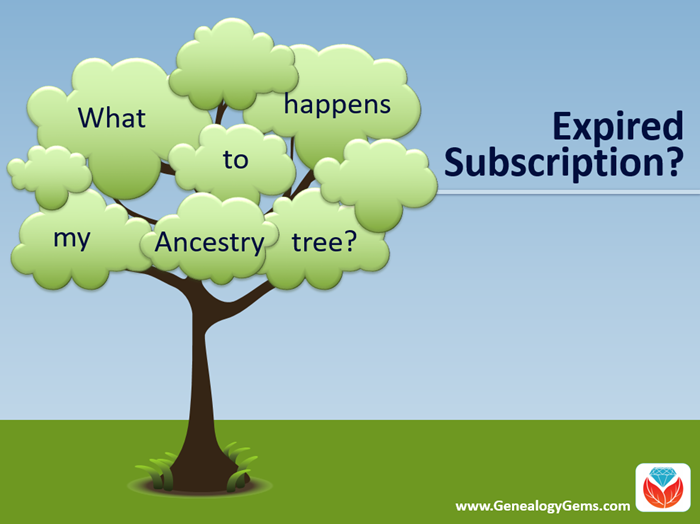
Many people start researching their genealogy with an Ancestry subscription. They build their family tree on the web site, adding details about their relatives.
Then they sift through Ancestry’s billions of historical records and add hundreds or even thousands of new names, dates, relationships and other facts to their family trees. Along the way, they attach records to each ancestor as evidence of what they’ve learned.
All of this adds up to a unique family tree that is precious to your family.
However, it is very common for the busyness of life to call them away from their genealogy research for a while. This is what happened to Genealogy Gems reader Beverly. She wrote to me, concerned about what will happen to all her hard work on that Ancestry tree:
“I have been a member of Ancestry.com for a long time and have worked on several trees. I love to work on my genealogy but lately have not had time. Can I drop my membership and still retain my trees? I plan to get my membership back at a later day. Right now I am wasting $20 a month.”
Beverly, I hear your pain!
We all go through busy seasons. It’s easy to cringe at the thought of paying for genealogy website subscriptions we aren’t currently using.
But the idea of losing all our progress on those web sites if we let our subscription lapse is worse. Your Ancestry subscription has not only included your online family tree, but also all of the records that you found and attached to that tree.
I did a little research along with Sunny Morton, Genealogy Gems Editor and our resident expert on the “Genealogy Giants” websites” (Ancestry, FamilySearch, Findmypast and MyHeritage). Here’s what we can tell Beverly and everyone else who is wondering what will happen to their family tree and all that research if their Ancestry account expires:
According to Ancestry, the answer is yes, you can still access your trees with your login credentials after your subscription lapses. The most important thing is that you don’t delete the tree or the account altogether.
Ancestry continues to host people’s trees because they want our tree data to share with others, and to give people a reason to come back!
But be aware that if you do not renew your Ancestry subscription, your account will revert to a free guest account. (Your user name and password will remain the same.) This means that you will not be able to access most of Ancestry’s historical records, including the ones you’ve already attached to your trees. And I say “trees” because many people have multiple family trees on Ancestry to be concerned about.
To see the historical genealogy records that you have attached to an ancestor in your online tree, click on a person in your family tree, and then click Profile:
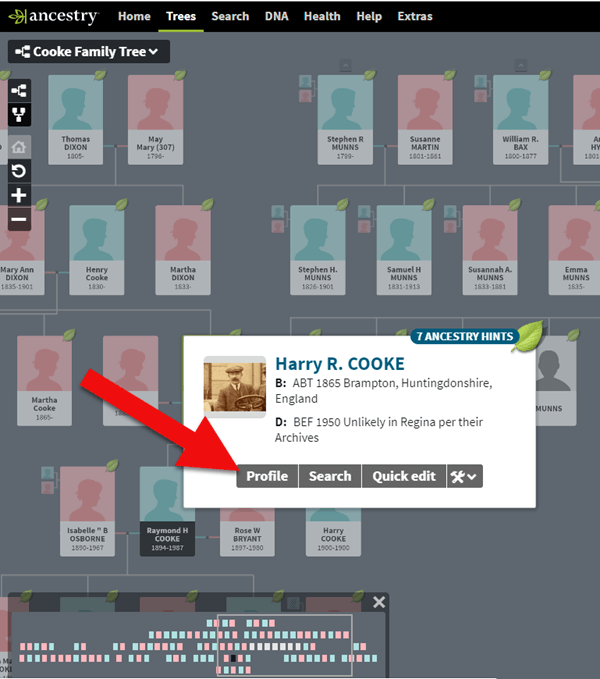
How to find genealogy records attached to a person in your Ancestry tree.
You will be taken to their profile page where you will see the genealogical sources you have attached.
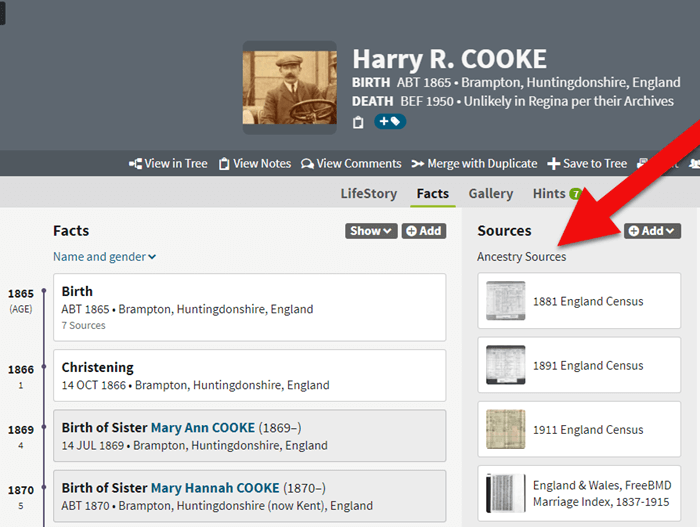
If your Ancestry account expires you can’t access records attached to your tree.
These are records that you will not be able to access when your subscription expires.
If you plan to let your Ancestry.com subscription lapse for a while, but you want to continue to work with your online trees, consider taking these steps:
The first thing to do is download a copy of every record that you’ve attached to your ancestors’ individual files on Ancestry.com.
You can do this by opening the image of the record, clicking on the Save/Saved button at the upper right, and clicking Save to your computer. I suggest doing this even if you don’t foresee letting your subscription go in the near future.
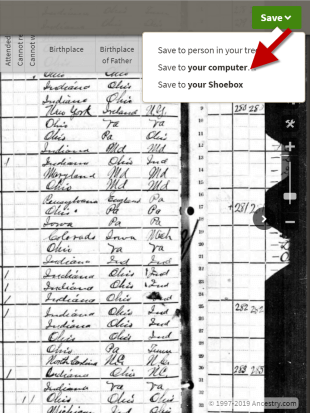
Saving a document to your computer from Ancestry before your subscription expires
I recommend using a consistent system to organize these, which I explain in the free Family History: Genealogy Made Easy podcast, in episodes 32-33. (Genealogy Gems Premium website members have access to a 2-part video tutorial on organizing their hard drives.)
If you don’t have a consistent way to organize these document images, you’ll soon become overwhelmed with files that all sort of look the same and you won’t be sure what year they are or which ancestors they pertain to without opening each one!
You may be wondering “What about cloud storage options, such as Google Drive or Dropbox?” These type of cloud storage solutions are ok too. However, I recommend using these platforms more as temporary or backup storage or to share with relatives, rather than as your primary storage.
A better alternative would be to invest in cloud-based backup for your home computer. I use Backblaze personally and for my business.
Click here for instructions; it’s really easy.
Yes, Ancestry does continue to maintain your trees, but what guarantees do you have?
Data loss does happen even on big websites, and sites change their practices and policies sometimes. If that happens, you could lose all the information you’ve carefully added to your tree.
Don’t just keep your family tree online where you don’t have complete control.
A “master family tree” is your most complete, up-to-date version of your tree (or trees, if you build separate ones for separate family lines).

Keeping your master tree on your own computer keeps all your tree data at your fingertips without any subscription required. Having one master file matters even more once you start sharing your tree on other websites or with relatives.
I use RootsMagic, and that is why I happily agreed to them sponsoring my Genealogy Gems Podcast. It works for Mac and the PC.
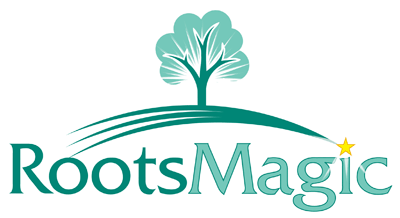
I like its affordability: there’s a free version you can try for as long as you like, and the full software will cost you the same as about 90 days of access to Ancestry.com.
RootsMagic also has solid relationships with the major genealogy sites: it now syncs with your trees on Ancestry.com and FamilySearch.org, and you can research records on MyHeritage.com and Findmypast.com.
RootsMagic has tons of advanced features to help you create family history charts, books, and reports, and a great user support community online.
Keep up with news and changes on the “genealogy giants” websites with our ongoing coverage of Ancestry.com, FamilySearch.org, Findmypast.com, and MyHeritage.com here.
Disclosure: this post recommends carefully-chosen products and services for which we receive compensation. Click here to read my full disclosure statement, and thank you for supporting the free content we provide at Genealogy Gems.
Here at Genealogy Gems we believe that genealogy is FUN, and finding great sources of information is part of that fun. But citing those sources may not be so much! My guest in Elevenses with Lisa episode 60 is going to make the case why source citation is a vital part of great genealogy research and she’s going to give us the resources to help get the job done right.
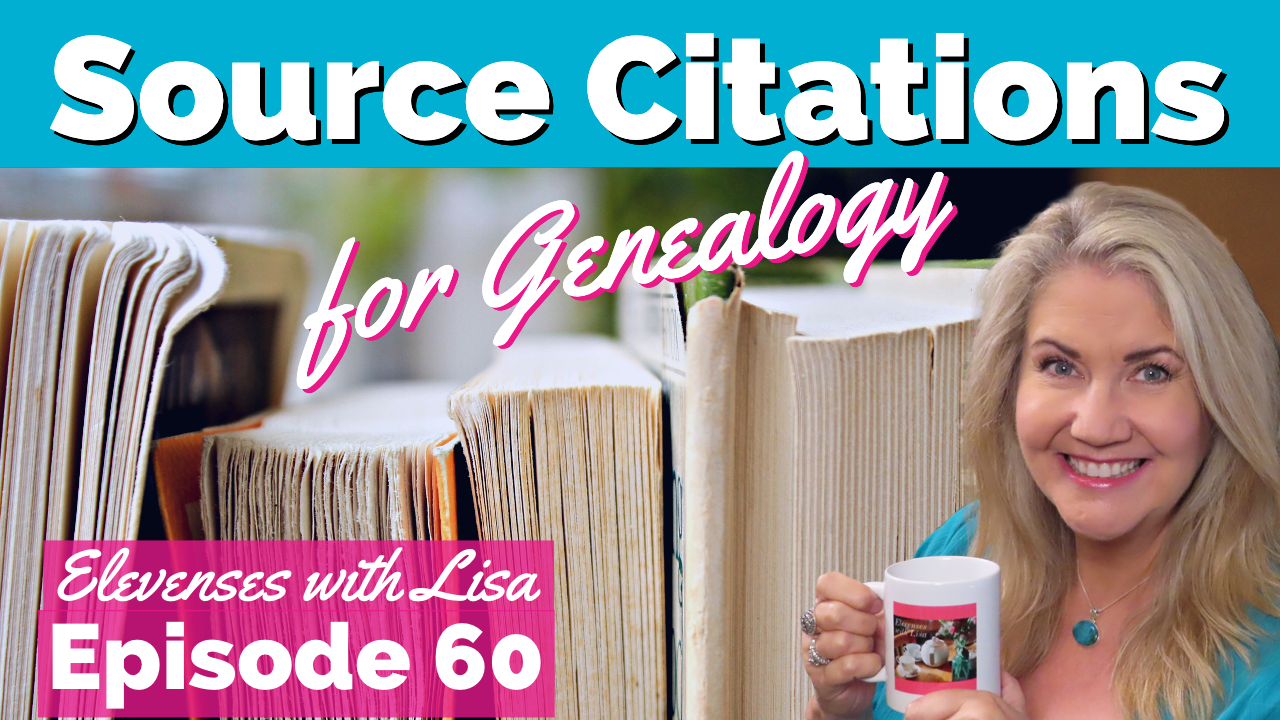
Elevenses with Lisa episode 60
Click here to add my channel to your YouTube favorites. Subscribing for free to the Genealogy Gems YouTube channel will make it super easy to return to my channel and Elevenses with Lisa any time you’re on YouTube. Thanks!
Premium Members can download the BONUS 2 page Genealogy Source Citation Quick Reference Guidebased on today’s episode. (Not a member yet? Click here to learn more and join today. Premium members can find the full length 18 page show notes PDF in the Resources section at the bottom of this page.
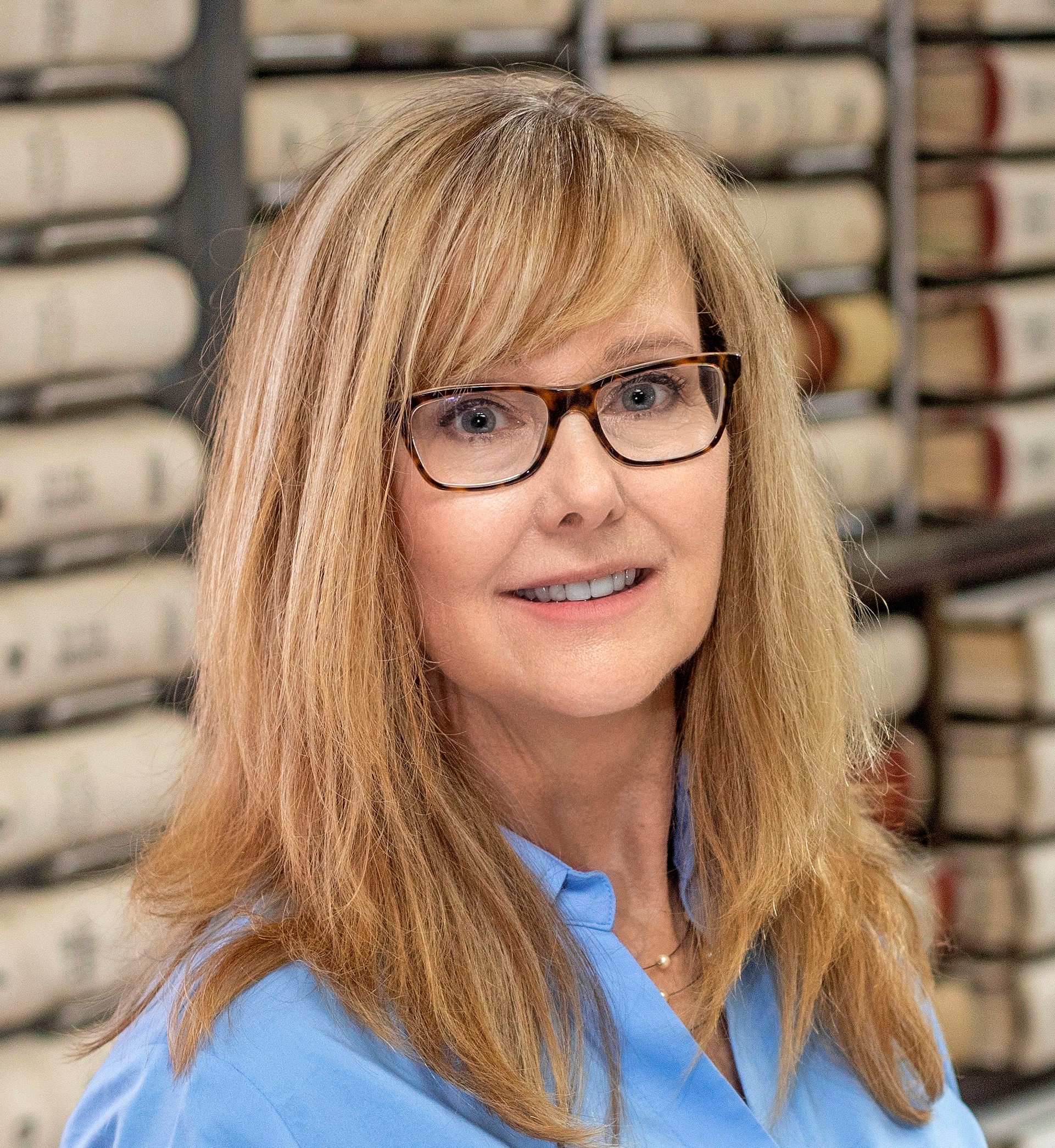
My special guest: Gail Blankenau
Lisa: Genealogy is FUN, and finding great sources of information is part of that fun. But citing those sources may not be so much! My guest in Elevenses with Lisa episode 60 is going to make the case why source citation is a vital part of great genealogy research and she’s going to give us the resources to help get the job done right. Gail Schaefer Blankenau is a history and genealogy research expert, author and speaker. She specializes in German genealogy, reading old German script in Midwestern and Nebraska roots, land records, as well as lineage research.
(01:31) Connie from Port Orchard, Washington wrote in recently to say, “I started researching my family about four years ago and your podcasts are very helpful. Thank you. Like many people, I started with the census where I discovered that a great great grandfather had fought in the Civil War. So, from then on, I was hooked. The reason I’m writing is to ask if you would consider doing an Elevenses episode on source citations. I wanted to do the right thing. So, I started researching for how to cite the digital newspaper articles I’d found. I was quickly bogged down in a quagmire of styles, punctuation, and metallics. That’s all well and good for academia. But I’m not writing a thesis. Thankfully, I have Rootsmagic to handle most of that. However, I still have problems when I want to cite my sources. Anywhere else like online trees, I stare at their form for a while wondering what to put there. And then I usually give up, I know I’m making it harder than it is. But I have an irrational fear that if I do something wrong, Elizabeth Shown Mills is going to find out and scold me. (Editor’s note: She won’t. She’s very, very nice!) You’ve done such a wonderful job of taking the mystery out of so many things. So please consider helping us conquer our fears, of citations.” Gail, I know that you’re the person who can help us with this. Do you hear this quite often from other genealogists?
Gail: I do. And I actually share her pain because even though I’m a published author in several genealogical journals, as well as genealogical magazines, I don’t always cite the way the editor wants. I just did a master’s thesis in history and I had to change some of my citing, and I was using genealogy citations. So, she’s right, there is a mix of citation styles. It sounds like she’s doing a good job at the main thing, which is to do good research. But when you want to share your research, people have to be able to check it. I have some ideas for her to maybe consider that we can talk in a little bit more depth today.
Lisa: Excellent. And I like your title, The Good, the Bad and the Ugly
Gail: And I’ve seen it all. I kind of call it the wild, wild west of citation of evidence because we have different citation styles. We as genealogists really enjoy the detective work. I mean, I love detective stories! And I like to solve puzzles. I think most of us who really get into genealogy are like that. So, when we get to the point where we have to maybe write it up or share it with others, we really need to cite our sources, even for ourselves. But you know what citation can be a little boring. And if you feel that way, you’re not alone at all.
(05:00) “Having to read footnotes resembles having to go downstairs to answer the door while in the midst of making love.” (Goodreads, Noel Coward Quotes, http://www.goodreads.com/quotes/185342-having-to-read-footnotes-resembles-having-to-go-downstairs-to : accessed 15 April 2017.)
Doing source citations feels like interrupting something that we’re enjoying, to do something really not that much fun. But I want to encourage you to cite as you go. And when I say cite as you go, it doesn’t have to be a perfect citation. But it’s important to have all the elements that you’ll need to massage it later. It’s a lot better than going back and redoing what you just did.
(05:35) Historians feel the same way. Anthony Grafton was a historian for Princeton. And he says, “Footnotes seem to rank among the most colorless and uninteresting features of historical practice.” I feel like genealogy is a subset of good history. He does, though, write about citations and their importance, because they counter skepticism from people who feel like there’s nothing that’s true. And there’s nothing that can ever be proven about the past. And so, although it might seem a little bit boring, the fact is, the evidence behind (the source citation) is not. So, we need to be really careful about citing sources, because sometimes we don’t have evidence for our assertions, or we have it but we’re not convincing people that we do.
(06:32) I’m going to quote Elizabeth shone Mills because she is considered the Citation Maven for all genealogy. “Citations are statements in which we identify our source or sources for a particular assertion.” (Elizabeth Shown Mills, Evidence Explained, p. 42.)
I would add that almost more important is that the sources for an assertion actually say what we say it does. We’re going to share some examples where they don’t do that.
(07:08) So here are just a couple of three of the style manuals that I’ve used both as a historian as, as a genealogist:
I have to say that when I did my thesis, my professor was talking about the census citation. Well, I used this Ancestry.com quick guide. I think it’s really good. Quick Sheet: Your Stripped-Bare Guide to Citing Sources Pamphlet I used it in my thesis. I had to go back and redo every single citation of my senior thesis!
(07:42) I should have asked ahead of time of my thesis advisor, “how do you want me to do it?” So that’s just a lesson we might have to learn. Some people find evidence explained citations to be too long, especially people who are going to do something in print. So, we do need to strike a balance.
Lisa: I think you’re making such a great point that part of the equation is what you’re going to be using the source citation for. Your thesis is a great example. It’s important to find out what’s required and what the guidelines are before you begin your project.
It’s also important to think about who your audience is. I know that Connie was saying that she’s not doing it for a thesis paper, she’s just doing it for her friends and family. Although, of course, it’s super important because her friends and family may want to pick up the genealogy down the road. If they can’t make sense of where any of her information came from, they’ll have to start all over. Right?
Gail: Right. And you don’t want to have to recreate the wheel. There are two problems that can occur with citations. One, that it’s not a good enough citation for people to find it. We’ll cover the elements that a good citation should have in just a moment. I’m not one of those people that gets really mad at you if you use a comma instead of a semi colon. I also don’t think there’s any one right way. But once you choose your way, whether it’s Chicago style or Elizabeth Shown Mills, be consistent.
There was an earlier book by Elizabeth Shawn meals that’s much slimmer that a lot of people use because they find Evidence Explained too much. They use her earlier book. I like A Manual for Writers of Research Papers, Theses, and Dissertations, Ninth Edition by Kate Turabian. They’re all based on Chicago style. Turabian gets it done for me most of the time. When I have a question that’s very specific to genealogy I might go to Evidence Explained. There’s no one right way.
I always think about the reader as well as the editor. I find out what the editor wants, but I also think about the reader. We’re all readers of genealogies. Think about what you experienced that didn’t go so well. When you were trying to figure out what someone was doing or saying in an article, or especially in the old genealogies that are not well referenced. Think about that. Pretend you’re that person who wants to find that source.
Let’s start with some ugly examples of source citations, and this should convince you why you need to have good citations. Whatever form you use, they need to be good, and they need to be complete.
There’s a man named Gustave Anjou. We should know something about him just by the fact that he changed his name. This is kind of a pen name that he used. He was a professional genealogist in the early 1900s. His real name was Gustaf Ludvig Jungberg.
He was hired by some wealthy families who had colonial American roots. They hired him to write their genealogies. The reason why I don’t want people to get so hung up on citations is that they lose track of doing good genealogy. He had lots of citations! And they were formatted well, and they were looked good. And most of them were good. Robert Charles Anderson, who is one of the more famous genealogists looked at some of these old genealogies and he said a lot of the citations were went to legitimate sources. And they were. They said what he said they said, but interwoven into all of these beautiful citations he basically put in false information. He told these people that maybe they were related to a nobleman or the signer of the Declaration of Independence, because really, back then a lot of people were doing it for reasons like feeling their roots were maybe a little bit more glorious than they were. The thing is, he was a fraud. But he did cite his work thoroughly, and they were well put together. People can make stuff up. And appearances can be deceiving, which is why I want us to always keep our eye on the main ball of citations that are informational. It doesn’t have to be perfect, especially if they aren’t going to be published. Your viewer Connie doesn’t need to really please anybody but herself. But I do want her to pretend that she’s the reader that might want to track down that citation and see the original. That’s mainly what we want to do.
Robert Charles Anderson did write an article (Fraudulent Lineages and More Fraudulent Lineages) about fraudulent lineages. If you Google Anderson fraudulent lineages you’ll see some of the early genealogies that were bogus. I have some families in there. When I was a beginner, I went to the genealogy library and I looked at some of these genealogies. I put them in my pedigree chart. And then later on when I went back to really do my real research, I had a lot of correcting to do! So, you might as well do it right the first time and know that there are some bad genealogies out there.
What we have to balance is the importance of citing your sources and getting it right. Source citations are so critical to our own research. We’re running across these kinds of things all the time. So, in a sense, we’re doing them for the benefit of others and making the case that to the best of our knowledge, this is accurate, and this is where I got it.
We all at some point probably hear from somebody who says, ‘I don’t know that that’s right.’ They see our online family tree or they want to question something we did. It’s nice to be able to go back and quickly be able to reorient yourself to where you got that information and be able to make that case. It doesn’t make you a bad genealogist to discover ‘Oh, gosh, he’s right, that person isn’t correct, or that document isn’t right.’ Or it may eventually turn out that the information has been disproven. So, we all want those trails leading back so we can make the fixes.
(17:19) I’m not saying don’t look at genealogies ever. You might you want to know what’s already been produced. But that literature search should also include the more prestigious genealogy journals.
One of my first major genealogy articles was in the New England genealogical historical register. And it was correcting the Mead genealogy. I think Spencer Mead did a good job on his direct line. But this was a comprehensive genealogy. My line was so wrong that I didn’t even know where he got it. And it wasn’t well referenced. I wrote a three part article, and that journal rarely does three parters. But there were so many errors that I corrected that it merited that large of an article.
Another time a person asked me, “well, where did you get that? Because the tombstone doesn’t say that.” If you have a good citation, then you’re OK. Your citation can even talk about discrepancies. I certainly don’t remember 10 years ago what my thought process was about that. I know I did the analysis.
I’m doing a book right now for the Nickerson Family Association. When I have something that I really feel needs discussion, such as there are two different birth dates or they’re two different death dates for this person, I talked about those sources and the comparison I did in the footnote.
Lisa: Wow, that’s a wonderful piece of information for those who will come after you later down the road. They will be able to see that discussion. I love that idea. What you’ve shown us so far as the ugly. You’ve got some BAD citations, too, right?
(19:00) Gail: I do. This is going to be my True Confessions. I started when I was really a teenager, and then I really got into genealogy in my teens. When I was in college, I was working at an office at college and taking classes. I ducked into the genealogy library on my lunch break. I’m interested in my second great grandfather, William Nicholas Johnson, and he was a civil war veteran. I’m just pulling everything off the genealogies shelf. That was back when they actually let you into the stacks. They don’t do that anymore. I had a little notebook that I would write things down in and then think “I’ll get back to it later.” And this was a note I had.

Gail’s original note about the source.
And I just laugh at myself, but kind of with the idea that I don’t want to cry about it. It says, “W N Johnson, Life Sketch Civil War.” Well, Johnson is a common, so I don’t know if it’s my guy or not. And it’s Maryville Tribune. I know, he’s from Missouri, but I left out Missouri. It would have been nice for other people to know, but I knew it. And it says February 18. No year? What book did I get it from? I have no idea. (I wrote it down quickly and then went onto other family lines.) Now it’s many years later, and I run across this cryptic, and I mean, cryptic little intro. That’s why I say cite your sources as you go.
I don’t care if you get them in the right order, but at least write it all down. Because you don’t want to go back to the library and try to figure out what book it came from. I finally did come across it in the Missouri Historical Review. And you can see I circled, basically, I wrote down what I circled.

The source of the note.
The year was on the prior page, which I didn’t write down. Maybe I thought I’d get to it sooner, but I didn’t. I spent quite a bit of time in the library tracking down the Missouri Historical Review. What if I had done something more like this:
“Historical Articles in Missouri Newspapers, January-June 1925,” Missouri Historical Review, Vol. 21, no. 2 (January, 1927), 321, Nodaway County, Maryville Tribune, 18 Feb 1925, “Life Sketch of W N Johnson.”
It’s super easy for me to check now. So not only do you want to do it for other people, but you want to do it for yourself.
Lisa: It makes me realize that it’s important to know the pieces, the elements within the source citation. Like you said, even if you just jot it down, and you intend to put together the proper citation later back at home at your desk, you’ll have all the pieces that should be there.
Gail: I never would have been able to use that citation in an article. But now I have a proper citation. It also led me to find out whether this was really my guy. By the way, if you do have Missouri ancestors, the Missouri Historical Review is a really neat resource. It’s digitized online now.
That’s a bad citation but there’s another kind of bad citation. I had a Bennett Posey Family. I think he is my fourth great grandfather, maybe third. There are probably thousands of trees online because we’re very prolific. They all have his wife as Rhoda Hobart. As a professional looking back I’m saying this wasn’t really Rhoda Hobart. This Posey Genealogy had really good citations and it looked good. Now I don’t think he was like Gustav Anjou trying to fool anybody. But I took a look at the citation to his will (and wills sometimes do help you to figure out who married whom.) The will doesn’t say at all what he said it said. That’s the other kind of bad citation you can find. I didn’t have a problem finding it. But the citation didn’t support the assertion. I looked at another will and I thought, oh, this was the will he meant. Even though it was closer to supporting it, it turned out that Rhoda Posey was a guy, not a girl. So, I don’t think Bennett married Rhoda Posey the guy. I think he married some other woman that I saw. She’s still blank on my tree because these days I’m doing everybody else’s genealogy research except my own. But that’s an example of another bad citation that didn’t support the assertion.
Lisa: That’s a great example. And it’s a lot easier to get help from other people, like a reference librarian, if you have a great source citation to offer them.
Gail: Yeah. I mean, they don’t even charge me which is nice. Other times they’ll charge five dollars. But a lot of times, they’ll say, “Well, unless you can give me a good citation I can’t help you.” Or you end up paying a professional to spend two hours chasing something down rather than just giving them where to look in the first place. They might be pulling a record for you that you don’t have access to online. There are a lot of things that can happen. So again, get all the elements, you can always massage it later, you can always check Turabian’s book or something later to get it right. So, source citations save us money! And time is money. No matter how you slice it, you really want to write as much down as possible and always think, “how am I going to find this again?”
Gail: I think I’ve convinced everyone not to get hung up completely on the format or wherever the comma goes. Just make sure you have all the elements that allow you and others to check it and make sure it really is saying what you think it says. I have a style guide for books that I use, so I copy and paste from there. Just be kind to yourself, but also be diligent. So, let’s talk about some good.
(27:49) This is the best part! Number one, I want to talk about types.
Sometimes I notice that people kind of get them confused. There’s a source list entry, which is kind of like the bibliographical reference. This is the actual source. You can have a full reference note, and that is for the first time you cite that particular source. These are usually longer. That’s the one that’s going to allow you to find it.
If you’re writing up your genealogy, then you have following or subsequent reference notes. This is out of Evidence Explained. But they say the same thing that The Chicago Manual of Style, 17th Edition
says, and the same thing that A Manual for Writers of Research Papers, Theses, and Dissertations, Ninth Edition by Kate Turabian. They all say the same thing.
Some of you might be MLA, some of you might be MPA. It doesn’t matter. We all have these three different types that we may be using. And here are the elements:
Now, depending on what you’re looking at, the elements will differ. You’ll want the title of the source or the creator of the source, and sometimes both.
Author(s), editors, or compiles – If you’re citing a book, you will want all the editors, the authors or compilers and say whether it’s an edited work, or a compiled work. You’ll want the publisher if there is one. Some things are self-published, and then I just put in brackets [self published] and the year it was published.
What it is? Is it a marriage book? Is it a Bible? What is it?
Page Number – If it’s paginated, if it’s not page numbered you say unpaginated. Do tell people that it’s not. Don’t make people guess whether there’s a page number so that they don’t obsess about it.
Microfilm Number – If you’re using microfilm, you need to put the film number because that’s what you’re looking at.
Record group name and # – If you’re looking at primary sources include record groups if they’re pertinent. If I’m at the courthouse, I include the courthouse and where the courthouse is. Sometimes I’ll put such and such a county, because how many Washington counties are in the United States?! Make sure you’re sure you say the state. Say that it’s in Bellevue, Nebraska, not just Nebraska. There might be more than one place like that in a state, not necessarily the same named county, but there might be towns with the same name nearby.
URL for online source – Obviously, if the source is online, you need to give the URL.
Repository (sometimes) – And sometimes you will want to have the repository where it used to be located. If you look at a book, say what repository you found it. If I looked at a book, if it’s a famous book, you know, and every genealogy library has it, you don’t have to put the repository. But obviously, when I’m citing the fugitive slave warrant, that I found at the Abraham Lincoln Presidential Library in Springfield, Illinois, I need to say where it is because no one’s going to be able to find it unless they know where to look.
All of those elements mean there’s no one right way, but you do have to make sure all the elements are in it. Once you choose the style, be consistent. If you’re using A Manual for Writers of Research Papers, Theses, and Dissertations, use it consistently. Don’t go off and do something else unless it really is an unusual thing that Turabian doesn’t seem to cover in her book and just try to do the best you can.
Lisa: I imagine it’s just like with naming your files on your hard drive. It’s probably more important to be consistent than to have it be somebody else’s view of perfection. You want it to include all the important pieces. So, that’s reassuring for folks to hear there isn’t just one right way. You’ve offered up some of the styles and things that we should be looking for. And I know you’ve got other resources as well that will help guide us in the right direction, right?
Gail: I do. The book Evidence Explained by Elizabeth Shown Mills is really good, but I don’t use it as much as I used to. And I do think it can be really daunting. There are people out there who will say your citation is wrong. They’ll say, “Well, if you want to stress the document, start with this, if you want to stress the person start with that.” I don’t know what they’re looking at. And I’m thinking “well, yes, it is actually that I wanted to stress the document, because this is a document and analysis. So, the purpose of what you’re using it for really, really matters. Just keep that in mind. Again, for your listener, she should stop stressing about it because she’s probably doing a good job.
(30:00) By the way of some of those reports – I don’t want to use names – but their databases that we use, I don’t always like the output that they do for their citations. But at least they’re there. But a lot of them are a little jumbled. And they don’t seem to adopt any particular style, though they have all the elements usually that you need. So that’s good. But I’m not into doing that.
I usually do my citations in a separate Word file. I always make my own style guide for every project. I have one source that was in what’s now Poland, but it was Pomerania. And I had my own style guide for that, because I was using an online Polish website that had digitized records. The records were in German, so I could read them. So for my citations for that I had the Polish name, I had the German, and then I have the English translation. I just decided I don’t want to rewrite every citation every time I cite this. So, for my reference, I had a style guide. And that’s a really good idea. Put the work in at the beginning, in a Word file and say, “Okay, I’m gonna spend some time maybe a whole day figuring how I want to cite it, but that’s what I’m going to use.”
Lisa: I like that idea. Using a template, it speeds things up, and it keeps it consistent.
(31:51) Gail: Exactly, exactly. And again, this was something that a lot of people weren’t citing, because they’re really daunted by the Polish website. It took me a while to learn how to navigate it. I don’t speak Polish, I speak German and English in French, and some Spanish but I learned it because I’m a genealogist and that’s what we do. Right? Genealogists are great learners. They will power through the most difficult things to get to where they want to go. So, we don’t want to let the daunting nature of citations continue to stop us from doing it at all. Better to do it, do it in your own style, your own template that you’ve come up with, hopefully, based on these resources that you’re providing, but at least doable rather than saying “Oh, I’ll do that later.”
Like I said, you can always rearrange some things or add an element later. But you need the main things, and you need to be consistent. You’ll save yourself a lot of trouble later on if you cite what you see. And this is also in Evidence Explained, but all the other style guides say the same thing.
If I’m holding the death certificate, I cite the death certificate. If I have a Bible, I cite the Bible and where it is who owns the Bible. Sometimes you have to say as of the year you referenced it. I may not know where it is this year, but at least you’ve got breadcrumbs.
(In the video Gail shared an example of a photocopied of vital records for James Arnold of Rhode Island.) I’m citing the book because I’m not looking at it online. I always check the original whenever I can. The reason I looked at the original is because there was a discrepancy in two sources. And then Cirilo said, oh, by the way, this is a copy too. And we don’t know where the originals are, we think they were destroyed when they were copied. He even gave me who copied it, and when. So that made it into my citation because this is as original as it gets. Sometimes when people transcribe, they don’t mean to, but they make an error. But that wasn’t the case here. But you have to do your due diligence. Whenever you see something that doesn’t make sense, or you have a discrepancy, you’re going to have to track down the original. And I still think it’s better to have the original anyway.
In another case, another Rhode Island one, I had a Samuel Reiss Smith within the vital records. But when I tracked down that original, it said Samuel Royal Smith, so it was my guy. I knew my guy was saying Royal because I had the Bible Arnold had, he just had a hard time reading the handwriting. So I went back and looked at the handwriting. Nope, this is Royal. So, you do want to get the original as much as possible. It made my case.
Which brings us to the very important subject of images. Most of us are using lot of images online. Remember, images might be enhanced. And that’s sometimes a good thing. It’s also sometimes a bad thing because there might be some things left out. The other thing is that there may be another one out there, but it may not be the same, kind of like the editions of books. And the series might have a gap.
In my thesis, I’m citing lots of censuses, and slave schedules, because I’m exploring some enslaved women who left enslavement in 1858 from Nebraska territory. I’m using the 1860 territorial census, and it’s online at Ancestry. It’s also online at FamilySearch. When I go to the Nebraska State Library and Archive, there’s a page at the front of the census for their county that lists all these slaves, all the enslavers and the number of people they have enslaved. And that is not online. But it’s critical if you’re looking for African American ancestors. So the census enumerator didn’t follow the rules. They were supposed to fill out a slave schedule separately, but they didn’t because it was a territory. So, they made it up. And there is a record, but it’s not online. So remember, if you’re looking for something and you’re thinking, Oh my gosh, it’s not there, you might have to kind of dig and look at the film and maybe even have someone go to an archive and say, “can you look at this?” Sometimes people don’t mean to but when they’re filming, they miss a page and, of course, it’s going to be the page that your ancestors on!
Lisa: Of course, that’s always the way it works. You know, Gail, you mentioned that images might be enhanced. Tell us a little bit more about what you mean by that.
(39:22) Gail: They might be enhanced by changing the colors so that it’s a little bit better and sharper, which is good. But for instance, I did a lot of my initial German research off of microfilms now at Matricula. For the Catholic records, they’re in color, and they’ve enhanced it by coloring it and sharpening them so they’re easier to read. There’s a lot of underlining done in German records, and sometimes the underlines are in red, and they didn’t show up on the microfilm and they show up on the digital image. So you do need to go back and kind of look at original images and see what you’re not seeing online.
Lisa: Being able to make a notation about this in the source citation. I mean, these days, my goodness, any digital image could be altered.
Gail: Exactly, and people can add things to them. And I have an example of why it’s important to say, even when you’re looking at what you think is an image of an original, (which is generally in genealogical standards considered almost as good as the original) But sometimes it’s not. So, this is where Evidence Explained is right. You do need to be really thorough. Are we doing good work? That’s always the question you need to ask yourself. Does that source that I’m citing actually support my assertion or not?
So this the top one, as you can see, it’s white on black. Now of course, that’s the microfilm. But we’re pretty sure the original wasn’t black on white. But they were having trouble getting a good image. So they changed it. I cited the film St. Andrews Verdan Evangelical Church. It’s unindexed. And it’s a baptism, 1800, and I give the FHL microfilm. And I added, thank goodness, citing film from a manuscript in Berlin. Now, she may not like that, she might want me to say what manuscript in Berlin it was. But you know what I feel like – and my history thesis person said – I cited too much. So can you find it? Yes, you can. That’s the question. But the reason it was important for me to put the extra thing about where the film and the manuscript is, is because Ancestry digitized it years later. And you start with Ancestry, usually, with the name of the database. You say that it’s a digital image, so that you know that you’re actually looking at a scan of some original. And in truth, St. Andrews Verdan Evangelical Church, and this manuscript is in the Niedersachsen, or Lower Saxony archive. And do you see any differences in those two things? Because I do right away. Number one, it’s a better image. But there’s a 42 on the lower one, and there’s no 42 on the other one, and the other one has page numbers, and the other one does not. They’re the same record, same church. If you don’t do a lot of German genealogy, what you don’t know is German parishes make duplicate records by law. So one is the duplicate and one is the original. The original is probably added to later by the actual parish person. Or the duplicate, they went back later and said, “This is hard to use, because we don’t have any page numbers or entry numbers, so we’re going to add them.” I love looking at originals, because you can see that it’s different ink, you can see whether it’s a different color. And with imagery, you can always see that. So that’s two, same person say project. One is easier to find the record than the other because they added the 42. And you know, all those stamps on your digital image at the census record. Those weren’t there originally. That’s why we say page numbers stamp or page number written.
Lisa: Exactly which can get very confusing when people are trying to go back and find things. You’re really also making the case of how important it is to familiarize yourself with the records that you are going to be using. You can discover things like the fact that in Germany they legally had to make these copies and they distributed them and that would be different in a different country where you’re researching. I love reading the full descriptions of the records, whatever I can get my hands on. Genealogy websites can tells you more about the background of the record, how they acquired it, etc. All of that could help support them making an even better source citation.
Learn more: Watch Elevenses with Lisa episode 37 Provenance: The Story Behind Your Genealogy Records.
(46:52) So the other thing, and I think I’ve kind of already alluded to it, is sources of sources. And this example is one from you know, the olden days. You can look at this in what they call the Massachusetts brown books. And this one is actually an image. So I’m going to add that I got it at AmericanAncestors.org.
Massachusetts Vital Records to 1850 (Online Database: AmericanAncestors.org, New England Historic Genealogical Society, 2001-2016), https://www.americanancestors.org/DB190/i/7687/338/141204368, Danvers Births, Vol. 1:338, citing First Congregational Church (Salem Village), Danvers.
Notice at the very end I say citing First Congregational Church, Salem village, Danvers. So it’s in the Danvers VRs, but it doesn’t mean that they were in Danvers, proper. So a lot of people might stop with Danvers, but that CR1 means Congregational Church, Salem village.
How do we find that out? If you’re online, you go to the beginning of the book and look at the abbreviations. Always see what’s in here. Does it matter whether your ancestor was a Baptist, Unitarian, Universalist, Congregationalist or a Quaker? Absolutely! So do know that those little citation citing something else, you need to kind of run that down and put that in your citation. That’ll help you and other people to make sure you know which John Smith you’re talking about. How many John Smiths do I have in my background? Quite a few! Was my John Smith, a Quaker? Well then it may or may not be the person who was at Salem Village in Danvers. And look: there’s two congregational churches in Danvers, one is Salem village, and one is in Middle Precinct.
(48:21) And again, talk about discrepancies. You know, my Bristol one? I had that said he was born 11th December, and one that said he was born ninth December. And both of them were copies of original records that can’t be found. So, I just say, I looked for the original records, did my due diligence can’t be found, here’s what may have happened, they’re two days apart, but it’s definitely the same guy, and here’s why. So always handle discrepancies in your source citations.
(48:42) Here are two source citations that are fine:
Somebody might write to you later and say that I’m wrong about this. But I have looked in Evidence Explained, I’ve looked in The Chicago Manual of Style, 17th Edition and either one of these is correct. But I wanted to show you why there’s no one right way.
I started with the first one William Shultz marriage license. And I like to use that format more where you say what it is, especially when you’re using end notes. I don’t know about you, but I really liked footnotes better because I could check right away. But a lot of editors and a lot of history books, you have to go to the end notes. So, if I want to check and there’s just tons and tons of footnotes, how much easier is it if you’re checking where I got the William Schultz marriage to start with a William Shultz marriage what it is? It’s easier to find for people, right? So, I always try to pretend I’m the reader who hasn’t been part of this big project that I know inside out.
Now, if it’s his license and certificate put that, because in some record sets the licenses are in separate books than the certificate. This one, the licenses is above and the certificate is below so it’s all one page. But I just let people know they’re both on here. But it’s not wrong for me to start with Saunders County Clerk who’s the creator, the marriage book, five 162, the record group because I’m looking at the archive. But I’m still looking at a film, I’m not at the courthouse. If I wanted to go to the Saunders County courthouse, then I would just say Saunders, county clerk marriage book five. And then I would say Wahoo, Nebraska, because that’s where Saunders county courthouse is. Now they know I went to the courthouse. You can do it either way. But make sure all the elements are there so people can check it.
Now I know some of your listeners might be wanting to publish an article or publish it for posterity, which is always good. I do encourage people, especially if you’ve done some really original research, that’s a breakthrough, I say get it published. Get credit for what you do, because people are going to take it from you, and they’re never going to cite you. I have a friend who’s done some incredible research. And I keep saying you got to write it up, you got to write it up! You are the expert witness. And it will actually help you to write it up, too. Because there’s where you see, “oh, maybe my train of thought was not as clean as I thought it was” or “Oh, I need to do a little bit more.”
(51:45) You might be thinking, “just tell me the right way.” But when I’m writing, the right way is how the editor wants it. You have to study the publication. (In the case of writing it up for your family, you are the editor who gets to decide.)
For the footnotes for instance. 1790 census in this particular journal, which is peer reviewed by professional genealogists: 1790 U. S. Census, East Greenwich, Kent Co., R. I., p. 59.
Here’s a footnote that is a published footnote in there. It’s following footnote, but it’s a good footnote. Notice that they abbreviate County, they abbreviate Rhode Island. And as some people might not even put R. I., they might just do RI. That would be just as good, but that’s not how this editor wants it.
Here’s a very similar footnote for this journal, New England Historical Genealogical Register, another prestigious journal very well: 1790 U. S. Census, Norwalk and Stamford, Fairfield County, Connecticut, roll 1, p. 326.
I mean, if you read it in there, it’s been well researched. It’s been well cited. That’s their footnote. Notice they spell county out.
Is one right, the other one wrong? No, they’re just different. And they’re both helpful. You can find them.
And here’s Evidence Explained: 1790 U. S. Census, Fairfield County, Norwalk and Stamford, digital image, Ancestry.com (http:www.ancestry.com : access date), entry for Smith Mead, p. 326 (written) line 22, citing NARA M637, Roll 1.
That very same one that I just showed you from New England. And you know, if you’re going to print it on a paper, paper is expensive. Ink is expensive. So they’re going to do the shorter one. It’s just how it is.
(53:15) And now access date. There’s still a debate about that. There’s a debate about whether you have to do HTTPS www ancestry.com. Some people are just taking that out, because everybody’s so familiar with Ancestry.com now, we may not need that whole URL. We just put ancestry.com, and everybody knows that. Or familysearch.org, access date. I usually put the year at least, because I’m already noticing that Ancestry.com has re- titled some of their databases. Just handle explaining your decision in the beginning of your book or paper. Explain where you’re coming from.
What I’m asking for is balance. I feel like there’s been a pendulum swing, because genealogists used to be really looked down upon by professional historians. There was a lot of sloppy genealogy done in the old days. Now I feel like sometimes we swing too far, you know. I do not always put that it’s the NARA publication number, blah, blah, blah, I put that in the intro. And then I shorten it because it’s going to be printed up and we don’t have the paper to do it. We just can’t waste all that paper. I’m being an ecologist here. But most good editors do strike that balance. They understand that, you know, it’s all about sources. It’s all about supporting your assertions. And as long as you’re doing that, you’re doing well.
Lisa: I like that. That’s a wonderful note to end on, which is, as long as you’re keeping these your audience in mind, you’re being consistent. You’ve turned to really reliable source citation reference materials like you’ve given us here. And we know we’re going to do a good job.
Gail: I want you to focus on the evidence, and the citations are your help. They’re not an obstacle, they should be your help.
Lisa: I like that idea very, very much. And the evidence is really the fun part, isn’t it? And we have to make sure we’re not so stressed out about source citations that we aren’t thinking clearly and evaluating the evidence that we’re coming across.
Gail: Right, exactly. I mean, I do think there’s some people who get too hung up on that, and they’re spending time on it that they could be using to do a little bit more analysis.
Lisa: Yeah, that’s a great point. And it’s easy to want to hyper-focus on what you feel like you can control. And you know, a lot of times, you can’t control the evidence, you can’t control your access to things. But we want to keep that end goal in mind of just do the best research that we can do. And you’ve certainly helped us with that.
Gail, tell folks, if they want to learn more about what you do, if they want to talk to you about research, how do they find you online.
Please leave your questions and comments below. Gail was kind enough to answer questions from the live chat:
Q: I’m used to APA citation format, is the citation format for genealogy a lot different?
A: Excellent question. It is similar, but different enough that you may want to use Turabian or Evidence Explained. Sometimes when I am in Worldcat.org I will look at the different style formats they have in a dropdown menu just to see what the differences are. Once you decide on a format, then be consistent.
Q: If we use Roots Magic, is it best to use their templates or should we create our own style? It is up to you.
A: The templates can be very helpful as we are less likely to leave important elements out. In my own experience, it takes me longer to input through templates, but the difference in time is probably not so much that it would be discouraging.
Q: Tips for using Ancestry’s citations?
A: Although they have improved their citations through the years, Ancestry’s citations do not always meet the genealogical standard. A resource I use is “QuickSheet: Citing Ancestry.com Databases & Images, Evidence Style*”
Q: How do you cite inherited genealogy scans like family Bible, letters, and documents that you don’t know where it came from?
A: I would consult Turabian for this. As far as you can trace provenance, you need to have that in the first entry citation. Here is an example:
Q: Where is Gail inputting her style guide source information within her genealogy software? Am I misunderstanding, she has a quick reference sheet she’s created in word, but how is she inputting it into her software of choice?
A: You are not misunderstanding. I have style guides for big projects that have a lot of repetitive elements. I have these in Word. I copy and paste into the manuscript. If putting it into software, I still copy and paste, but not all at once, as different programs have you input titles, authors, etc., in different order. Example: Census (U. S.) 1850-1870
*year U.S. census, * Co., *state abbreviated, *township, p. #, image database, database URL, dwelling#/family #, *name of individual and/or head of household.
Q: What does it mean in a citation to say “citing ” (as in “citing film”)?
A: It is a good practice to mention what you are either looking at or holding in your hand. So, I might say “Washington Deaths,” image database, website URL, accessed date, entry for NAME, date of death, citing FHL microfilm, etc. This tells the reader that I am using an image database, but that the digital image is a copy of a microfilm, not the original paper death register. So, I cite the microfilm, because that is what the image represents. I do not always use the terminology, “citing” but often I do when I am dealing with digital image databases. Some researchers still use access dates, but for instance, in my Master’s thesis, they did not want so many dates and long citations, so we said accessed in 2020, or in some cases, “various dates in 2020,” rather than littering it up with long date formats.
Q: Are templates for sources to be done for each project? Can templates be used over and over?
A: I use my Word style guides over and over, regardless of project. However, I also have special projects where I have a separate one. What I normally do is take my “usual” style guide and adapt it or add to it. For instance, I have one for when I am using the Polish State Archive, with my “normal” citations, plus the idiosyncrasies of that archive, another for when I’m primarily using Archion, and another one for the large book project (mainly Massachusetts but ultimately nationwide and into Australia), and of course, I have a separate one for the book I am writing under contract.
Q: My mother wrote a lot of things down for the family historian (me), some were dictated and some in her handwriting and actually some from a previous generation. For my personal genealogy can I use these as a citation? I plan on scanning her notes and adding it to my computerized tree and the originals in my wonderful books of saved documentation. (The class you did many moons ago)? Thanks for a wonderful cl
A: I love this question. Yes, I would cite your mother’s work. If dictated and you were the writer, you may want to call it interview notes, and the date, if you have it. Her own notes you would cite her as the author/compiler. Again, I would consult Evidence Explained and/or Turabian for this situation, and then decide what format and order you want to use. Once you establish your “first entry” note, you can then use a short form note for any other references to that particular part of your mother’s research.
In this episode, we’re going to be visiting two of the most pivotal states in the U.S. for genealogy research. These states played key roles in the development and expansion of the United States of America, and we’re going to explore a top online resource for each.
First up is the state of Pennsylvania, officially known as the Commonwealth of Pennsylvania. It was founded in 1681 through a royal land grant to William Penn, and established as a haven for religious and political tolerance. And since for over 300 years the port of Philadelphia was a major gateway for arriving immigrants, many many family trees include people who passed through Pennsylvania. One of the best and most important resources for records of interest to genealogists is the State Library of Pennsylvania, and we’ll be exploring it today with Kathy Hale, the Government Documents Librarian, and Amy Woytovich, the Genealogy Librarian at the State Library of PA.
Then we will head west to Ohio which joined the union back in 1803, and where many of our ancestors settled, or passed through on their way West. The Ohio Memory website is a rich source of historical materials that tell the story of this state and potentially many American families. Jenni Salamon, the Ohio Memory Digital Services Manager will be joining me to explain the depth of the available materials and provide insight into how to best navigate the website.
The library has been a federal repository library since 1858, and is one of the oldest in the country. The government printing office deposits materials here.
The State Library of Pennsylvania physical collection includes:
The State Library of Pennsylvania digitized items include:
Pennsylvania Documents
Example: a report for Pennsylvania of the 25th and 50th anniversaries of the Battle of Gettysburg. Includes information gathered at reunions including names, pictures, and more.
U.S. Government Documents – Serial Set
This collection includes reports to the legislature from agencies and institutions. Example: The Daughters of the American Revolution (DAR) were compelled to provide to Congress a yearly report of the names of people approved by DAR. These can be accessed through many libraries, the federal government or by contacting the State Library of Pennsylvania via email: Ra-reflib@pa.gov
Amy discusses research guides available on the website. However, here is the link to the topics she specifically mentions such as Cemeteries and Zeamer collection – recorded information about Cumberland County PA cemeteries.
These research guide pages include links to additional helpful websites.
At the top of the page look at the For General Public tab which will take you to all of the genealogy research guides. Visit the Genealogy page at the State Library of Pennsylvania.
The library’s collection of newspapers includes papers from all 67 Pennsylvania counties on microfilm. They do have a lot of digitized newspapers at the Pennsylvania Photos and Documents Collection at the Power Library.
You can find the Power Library by going to the libraries home page, and under the For General Public tab go to Our Collections > Power Library. Or visit the Power Library website at Powerlibrary.org.
Electronic Databases: you have to be a resident with a library card.
Digital Documents: you don’t have to be a Pennsylvanian to access this collection.
At the top of the Power Library home page on the right you’ll find Digital Docs and Photos.
There you will find many materials from Pennsylvania colleges including yearbooks. You can browse by subject area, with Genealogy being one of those areas.
At the time of the interview the library was not open for interlibrary loan and lookups. Check the website for the latest updates.
The library does loan its newspaper microfilm. Up to 5 reels of microfilm per request. Kathy says that if you find a newspaper article at Newspapers.com and you see the title, date and the page that an article is on, you can provide the information to the interlibrary load reference librarian at your local library and place a request for a scan of the article from the State Library of PA microfilm. The article can then be returned to you digitally through interlibrary loan. The digitized scan is yours to keep.
Amy’s Pick: Historic maps found at the library’s website Home > For General Public > Genealogy and Local History > Maps and Geographic Information. This includes Sanborn Fire Insurance Maps. Note: log in with a library card may be required. Contact the library with questions.
Kathy’s favorite collections include:
Usage rights and copyright are important considerations when utilizing library materials. Usage depends on the individual item’s copyright. It should be researched as much as possible. Check the meta data of digital images for copyright information.
“Think of Amy and I as your personal librarians.” Kathy Hale, Librarian
Contact State Library staff by phone at 717-787-2324 or by email at:
Learn More About the State Library of PA Collections
In episode 43 of Elevenses with Lisa we discussed genealogy records available for free at the Internet Archive. The State Library of Pennsylvania has been partnering with he Internet Archive to digitize many additional items from their collection. You can access these items for free at the State Library Internet Archive Collection. This collection includes a large number of World War I materials as well as a growing number of 19th and 20th century pamphlet volumes.
Maps for Genealogy
At the website go to Home page > General Public Tab > Our Collections > Search our Resources
On the map viewer page, click the thumbnail button (looks like a checkerboard) to see multiple pages at a time. You’ll find the Download button in the bottom right-hand corner. The Print button is in the upper right corner.
Cite your source: Go back to the result page, and scroll down. Click the red button called Cite This. This allows you to copy the source citation which you can then paste into other documents and programs.
Newspapers for Genealogy
The Library of Congress Chronicling America website has many Pennsylvania old newspapers, but it doesn’t include all of the newspaper that the library has in its collection. Here’s how to find old Pennsylvania newspapers at the State Library website:
This tip comes from my book The Genealogist’s Google Toolbox and my Premium Membership video The Genealogist’s Google Search Methodology.
Many websites have their own search engine. However, each search engine is only as good as it was programmed. If you can’t find what you want on a website like the State Library PA website, try using a Google site search. Site search tells Google to search for your search terms only on the website you specify. Here’s how to do it:
In my example in the video, you can see that Google found the one page mentioning the surname in a listing of microfilms much faster than I would have found it digging around and navigating the website itself. This page was not a card catalog entry so it would not have come up in a search of the catalog on the website.
On long pages such as in my example, I use Control + F (Windows. Command + F on Mac) to quickly find the surname on the page.
Website: https://ohiomemory.org
Special Guest: Jenni Salamon, Ohio Memory Digital Services Manager
If your family has any connection with the state of Ohio – and sometimes I think it’s hard to find anyone who doesn’t have at least one ancestor who did – then you’re going to love the Ohio Memory collection and website.
Even if you don’t have a direct connection with the state of Ohio, like all collections it’s worth taking a peek. Records don’t care about state lines, and many items in the Ohio Memory collection touch far beyond the Ohio border.
OhioMemory.org was featured in Family Tree Magazine’s 75 Best State Genealogy Websites list in a recent issue of the magazine. I host the Family Tree Magazine podcast, and recently had the opportunity to interview Ohio Memory’s Digital Services Manager, Jenni Salamon for that audio show. Since there’s so much to see at Ohio Memory I’m excited to share the video of that conversation.
Ohio Memory is the collaborative digital library program of the Ohio History Connection and the State Library of Ohio. Established in 2000. It was originally established as a bicentennial project they wanted a way to capture some of Ohio’s history and share it more broadly. Ohio turned 200 years old in 2003.
Ohio Memory worked with institutions around the state to build the online collection. They picked their favorite collections which were then digitized and made available as an online scrapbook. Initial submission by 260 institutions resulted in over 13,000 contributed items, and Ohio Memory continues to grow.
Most of the contributing organizations are public libraries, and some are university libraries. Other organizations such as historical societies, government institutions, special libraries, religious archives also contribute to the collection.
A wide-variety of materials make up Ohio Memory including:
All 88 Ohio counties are represented in the Ohio Memory collection.
Everything at Ohio Memory is digital and keyword searchable thanks to Optical Character Recognition (OCR). However, they do sometimes connect back to other catalog records.
When you use the search box on the home page you will be searching both the text and the metadata provided by the contributor. If you want to search just visual items (photos, images, etc.) select “exclude full-text sources.”
It’s important to use keywords relevant to the time period that you are searching. Restrict your format to what you want right from the homepage.
The newspaper collection of Ohio Memory does not overlap with the Library of Congress’ Chronicling America collection, but they are all part of the same story and collection. They have contributed a large amount of newspapers to Chronicling America over the years. At last count there are a million pages between the two collections.
Ohio Memory focuses on titles and time periods different from the content on Chronicling America. At Ohio Memory you’ll find deeper runs of newspapers and more recent newspapers. New newspaper content is being added regularly.
They also have some very early newspapers that are significant to Ohio history such as the Ohio State Journal which was the paper of record for Ohio during the 19th century. The Ohio State Journal collection covers 1830-1875 an important time period in Ohio’s growth and the Civil War.
The Lebanon Western Star newspaper from southwest Ohio near Cincinnati and Kings Island is another important newspaper. It covers Ohio history from a more rural area.
A lot of Ohio Memory’s public library partners have access to yearbook collections through their partnerships with local schools. Many have worked to digitize their materials and put them on Ohio Memory. Some are quite early, some more recent although not very recent due to privacy concerns.
Many of the yearbooks at Ohio Memory come from northwest and northeast Ohio. You’ll also find student histories from southwest Ohio from a couple of universities, as well as other related materials such as student photos.
Yes! They used to have one collection that was behind a pay wall. That was the Underground Railroad Wilbur H Siebert collection which features information about underground railroad activities in Ohio and beyond. It’s a strong resource for looking at research methods of the era, and the stories of how the underground railroad operated. That collection was opened up a couple of years ago and has remained free.
Videos, an FAQ and search guides are available to help you learn how to dig into the Ohio Memory website. You can also reach Ohio Memory by email for additional assistance.
They continue to digitize and add new materials based on their strategic goals. Recently they focused on President Warren G. Harding since it is the 100th anniversary of his election. They are continuing to add more content to that collection.
Ohio Memory has about 40 active partners around the state that are choosing items from their own collections for inclusion. Examples include Wood County in northwest Ohio, Mount Saint Joseph University and the Sister of Charity in the Cincinnati area. They welcome new partners every year.
While you may or may not find things specifically about your ancestors, Ohio Memory offers a wonderful opportunity to find things that help fill in their story and their community.
You are free to use items for educational and personal use without needing extra permission. If you’re a family historian and you are wanting to put a picture in a presentation for your family or you just want to keep it with your own research records, you are welcome to do so.
Jenni Salamon, Ohio Memory’s Digital Services Manager says that if you want to post something on social media, simply include a link back to the Ohio Memory site so others know where it came from Ohio Memory. If you want to use an item for a formal publication or commercial use, contact Ohio Memory. Copyright varies by item and research is required.
Fort Wayne, Indiana is the home of the second-largest free genealogy library in the country. Make your plans to visit today. Learn more at https://www.visitfortwayne.com
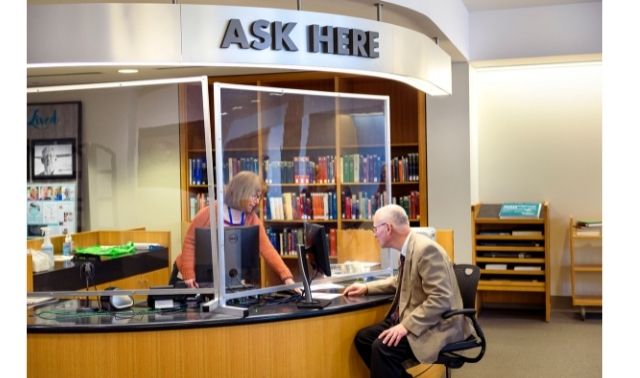
Learn more about the free genealogy resources atVisitFortWayne.com
Premium Members have exclusive access to:
Become a member here.
Don’t miss the Bonus audio for this episode. In the app, tap the gift box icon just under the media player. Get the app here.
The Genealogy Gems email newsletter is the best way to stay informed about what’s available with your Premium eLearning Membership. Sign up today here.
Ancestry.com is packed with all kinds of mostly-undiscovered genealogical treasures, and some of them you’ll never find from a search box.
Here, expert Nancy Hendrickson shares some favorite treasures, tips for finding those treasures, and helpful reminders for improving your genealogy research.
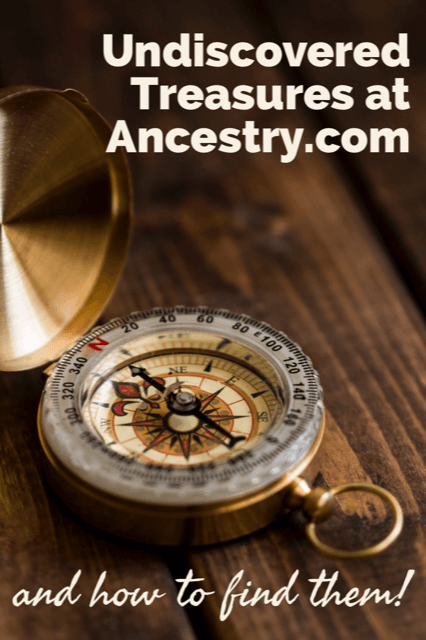
(We provide links for your convenience to the various online resources and some may be affiliate links for which we receive compensation at no additional expense to you. Thank you for your support.)
Ancestry.com is a “genealogy giant:” one of the four biggest global records resources. Whether you subscribe or have free access through your local library or Family History Center, you should not miss exploring this website for your family history.
Ancestry is also a financial investment. If you’ve been using the site for quite a while, you may be wondering if you are really getting all you can out of it’s vast genealogical record collections and many research tools.
Nancy Hendrickson, the author of The Unofficial Guide to Ancestry.com and the Unofficial Ancestry.com Workbook: A How-To Manual for Tracing Your Family Tree on the #1 Genealogy Website knows the website inside and out. Today she’s sharing four great tips for taking your research to the next level. In addition, we’ve added in some examples and additional things to consider. So let’s get started using Ancestry more effectively.
Any single record can be wrong, incomplete, or misread by you or by the person how indexed it. Double check the assertions made in the record by looking for that same information in additional sources. Be careful to make sure your sources weren’t getting their information from the same person or place. Otherwise, they’ll naturally say the same thing!
Nobody wants to discover conflicting information, of course. But you do want to know if something is inaccurate before it leads you down a wrong research path.
The best thing about verifying facts in additional sources is that sometimes you find NEW or BETTER information such as:
For example, let’s say you find an ancestor’s death date in the Social Security Death Index. While it’s a great source, don’t stop there!
Like any record, the SSDI is sometimes wrong and the information it contains is definitely limited. Use the Ancestry.com Card Catalog to see what records about death may be on the site for that time and place. You’ll find the Card Catalog under Search in the main menu.
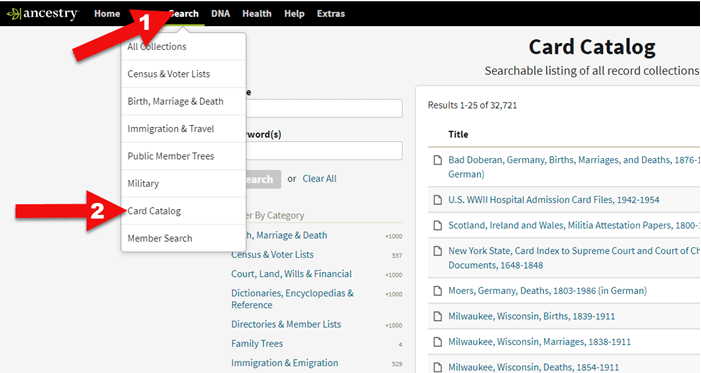
Ancestry Card Catalog
Use the filters on the left side to drill down to death records for the location you want. Remember that records collections have been created on a specific geographical level: try local, regional (such as state or province) as well as national levels.
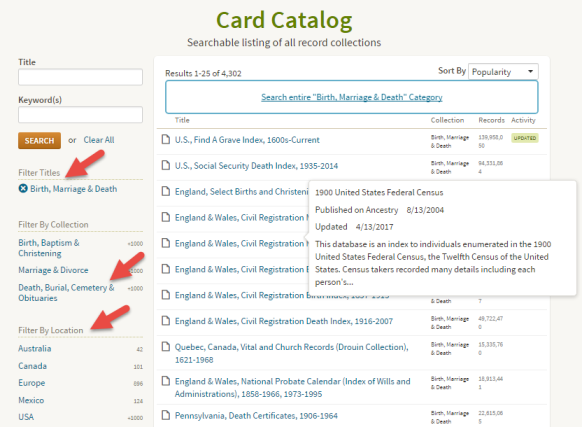
Using the Card Catalog search filters
Seeing the same information over and over can provide a false sense of accuracy. Remember, just because seven different online trees name the same parents for one of your ancestors doesn’t mean those are the correct parents. Those Ancestry users may all be misquoting the same wrong source without actually verifying the information!
You often come across likely matches in others’ trees when you review Ancestry’s automated “leaf” hints, or when you run a general search on a name. When you do, it’s simply an indication that the tree may be worth exploring. Here’s an example:
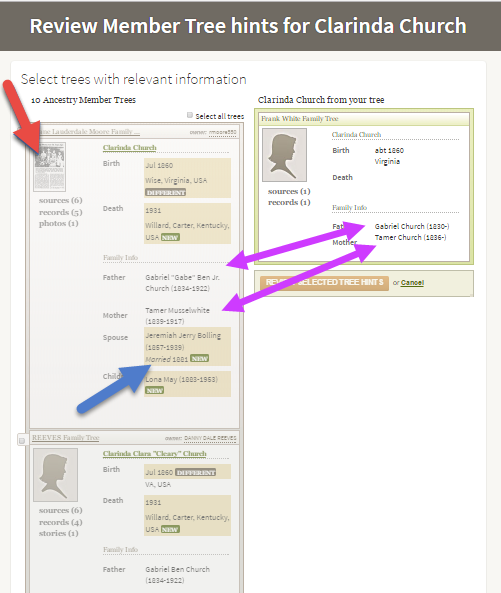
Exploring Ancestry Hints
Let’s take a closer look at this example.
The purple arrows: You can see that multiple pieces of very specific information are the same on your tree and another one.
The red arrow: You see sources attached to that person’s profile, such as the news article thumbnail image. (Note the difference with the record shown below, with just an empty profile image.) Yes, you will definitely want to review that news article!
The blue arrow: In addition to either of the above, you also see specific information that is unknown to you.
This tree profile looks promising enough you might naturally consider reviewing the tree hint and attaching it to yours. But then you wouldn’t be able to see the news article or other sources attached to that tree.
Instead, click the checkbox and then click the name of the tree to look at it and its attached sources:
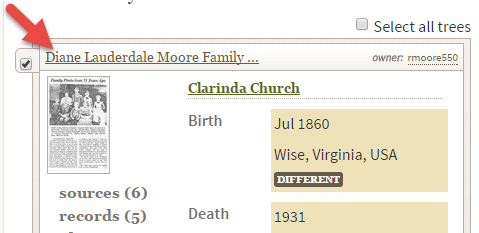
Select the tree to review it more closely.
Then you’ll be able to check out the news article along with the other sources and records attached to this person’s profile. You won’t just see what that person thinks about your common ancestor – you’ll see evidence of why she thinks it.
Nancy reminds us that “Ancestry.com is a fantastic resource for old maps, stories, photos, published county histories, and more. For example, looking at the old maps in their collections can reveal the true nature of an ancestor’s daily life, hardships, travels, and more. And your chance of finding early American ancestors is high in county histories: there were fewer people and early settlers were talked about, even if the family wasn’t wealthy or prominent.”
Here are some of Nancy’s favorite collections at Ancestry:
This collection includes nearly 7 million records extracted from about 1,200 county and land ownership maps from across the country. These are indexed by property owners’ names.
According to the collection description, “They also indicate township and county boundaries and can include photos of county officers, landholders, and some buildings and homes.”
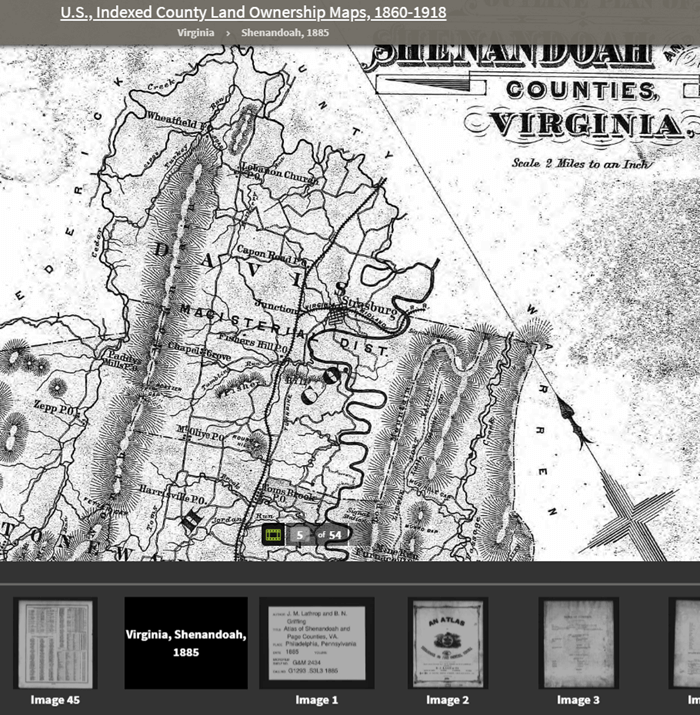
Example: Shenandoah Counties, Virginia – included in U.S., Indexed County Land Ownership Maps, 1860-1918
This is a browse-only collection of “more than 2,200 volumes of county and regional histories from California, Illinois, Indiana, Michigan, New York, Ohio, Pennsylvania, and Wisconsin.
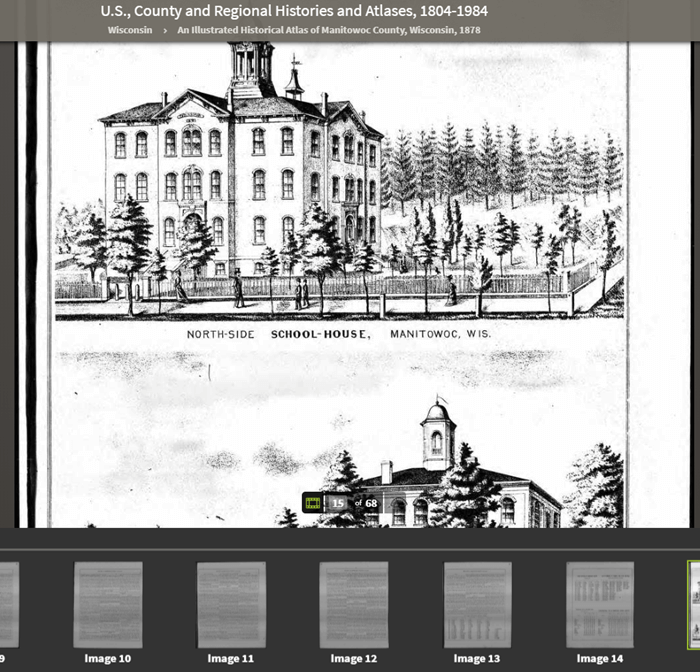
An Illustrated Historical Atlas of Manitowoc County, Wisconsin, 1878 in the U.S., County and Regional Histories and Atlases, 1804-1984 collection
In them you’ll find history, biographical sketches, maps, business notices, statistics and population numbers, pictures, descriptions of industry and business, stories of early settlement and pioneers, colleges and universities, military history, geography, and plenty of other details.”
Reminder: you can’t search this database by an ancestor’s name. Instead, look for places, and then start reading.
A collection of maps and atlases detailing land areas that comprise the present-day United States and Canada, as well as various other parts of the world. It contains a variety of maps and atlases created for different scopes and purposes, including land ownership atlases and bird’s-eye view maps.

Warrant Plan Records in the Historic Land Ownership and Reference Atlases, 1507-2000 Collection at Ancestry
Land ownership atlases usually show the names of contemporary owners or occupants of land and structures.
Some of the maps depict countries and wider geographical areas, while others depict counties, cities, towns, and smaller geographical areas.
Ancestry owns a lot of other web resources. Search these too!
Nancy says, “They include Find A Grave, Fold3, and RootsWeb, one of the oldest online genealogy communities around. Don’t give up! Keep looking in other places for the information you want to find.”
Search results from Ancestry.com do include Find A Grave entries. Many of these contain additional information about the deceased and links to their relatives. As always, be sure to confirm the information you find here.
Fold3 is home to millions of U.S. military records. Ancestry.com subscribers can upgrade their subscription to include Fold3 access, or you can subscribe separately.
RootsWeb is a free and long-lived family history web resource, now hosted by Ancestry.
“The primary purpose and function of RootsWeb.com is to connect people so that they can help each other and share genealogical research,” says the site. “Most resources on RootsWeb.com are designed to facilitate such connections.” You can use RootsWeb in a variety of ways: search it, contribute records, upload your family tree, post your family surnames on a board others can see, and more.
Ancestry has changed one of the ways RootsWeb users have traditionally connected: Mailing Lists. According to the website:
“Beginning March 2nd, 2020 the Mailing Lists functionality on RootsWeb will be discontinued. Users will no longer be able to send outgoing emails or accept incoming emails. Additionally, administration tools will no longer be available to list administrators and mailing lists will be put into an archival state. Administrators may save the email addresses in their list prior to March 2nd. After that, mailing list archives will remain available and searchable on RootsWeb. As an alternative to RootsWeb Mailing Lists, Ancestry message boards are a great option to network with others in the genealogy community. Message boards are available for free with an Ancestry registered account.”
Nancy shares many more Ancestry tips and treasures in her Unofficial Ancestry.com Workbook. To get the most out of this book read the section on using the Ancestry.com Catalog. Nancy does 95% of her research in the catalog. The workbook is divided into topics, such as military records, so choose a chapter that fits your current goals. It’s also important to not just read the workbook, but also do the exercises. They teach you Nancy’s thought processes for how she finds specific answers or approaches certain types of problems. Then you can apply the same concepts to your own research. Don’t miss the chapter on social history. That’s where you’ll dig into everyday life. And finally, take advantage of the forms that are included. They will help you log your findings and analyze what you’ve learned.
Browse-only collections at Ancestry and other genealogy websites are sometimes viewed as inaccessible, but they are actually a hidden treasure. Click here to read How to Find and Browse Unindexed Records at Ancestry – The Better Browsing Checklist. In this article you’ll learn how to access these browse-only collections at Ancestry and expand your family history research.
